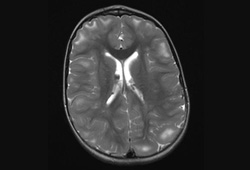Last reviewed: 16 Mar 2025
Last updated: 07 Jan 2025
Summary
Definition
History and exam
Key diagnostic factors
- family history
- epilepsy
- cardiac rhabdomyoma (single or multiple)
- renal angiomyolipomas
- lymphangioleiomyomatosis of the lung
- cerebral subependymal calcified nodules
- multiple cortical tubers and/or radial migration lines
- giant cell astrocytoma
- facial angiofibromas
- cephalic plaque(s)
- nontraumatic ungual or periungual fibromas
- hypomelanotic macules
- shagreen patch(es) (connective tissue nevus)
- retinal nodular hamartoma(s)
- polycystic kidney disease
Other diagnostic factors
- numerous dental enamel pits and intraoral fibromas
- autism
- cognitive impairment
- behavioral problems
- multiple hamartomatous colonic polyps
Diagnostic tests
Tests to consider
- genetic testing
- brain MRI
- neurodevelopmental assessment
- electroencephalogram (EEG)
- ECG
- echocardiography
- abdominal MRI
- glomerular filtration rate (GFR)
- blood pressure
- high-resolution chest CT
- pulmonary function tests and 6-minute walk test
- skeletal x-ray
- colonoscopy
- renal biopsy
Treatment algorithm
Contributors
Authors
Francis J. DiMario Jr, MD, MA, FAAP
Professor of Pediatrics and Neurology
University of Connecticut School of Medicine
Associate Chair for Academic Affairs and Faculty Development
Department of Pediatrics
Academic Chief Emeritus
Division of Pediatric Neurology
Connecticut Children's Medical Center
Hartford
CT
Disclosures
FJD is an author of a number of references cited in this topic.
Peer reviewers
Robert Robinson, MBBS, MA, MRCP, PhD
Consultant Paediatric Neurologist
Great Ormond Street Hospital
London
UK
Disclosures
RR declares that he has no competing interests.
David Neal Franz, MD
Professor of Pediatrics and Neurology
Director
Tuberous Sclerosis Clinic
University of Cincinnati College of Medicine
Cincinnati Children's Hospital Medical Center
Cincinnati
OH
Disclosures
DNF declares that he has no competing interests.
Use of this content is subject to our disclaimer
